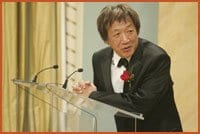It was a heady day for gay Asian visual artist Paul Wong Mar 16 when his peers recognized him with a Governor General’s Award in Visual And Media Arts.
He’s been an artist, curator, teacher and mentor for 30 years. But Paul Wong is also a crusader for freedom of expression, and against the practice of censorship. And sadly, he’s had his share of practice.
Take, for example, the 1984 decision by the director of the Vancouver Art Gallery to pull the plug on Wong’s video installation only hours before its premiere in the gallery’s new video exhibition space.
So it is not without irony that as vigorous an advocate of freedom of expression as Wong should receive the ultimate establishment nod for an artist: a Governor General’s Award. And it’s doubly ironic that he receive this award in Visual And Media Arts at precisely the time that Canada’s Parliament is debating legislation that could result in criminal charges being laid against artists for creating important art.
Medal in hand, Wong is steadfastly opposed to the legislation.
“Regressive legislation like what is proposed in C-2 completely dismisses art, arts education and artists; it marginalizes everything.”
Bill C-2 claims a noble purpose – protecting children and the most vulnerable in our society from sexual exploitation. But along the way it overshoots in a way that has left artists and gay men scratching their heads. It removes the artistic merit defence and criminalizes legitimate artistic comment and exploration.
“Historically, it has been shown time and time again that it is the artist who has had the guts and the vision to reflect the world around them,” says Wong. “We as artists speak the truth. And looking at the truth when we live in such a state of denial is difficult. And you can’t argue with the truth.”
That truth is something the Canadian Conference Of The Arts (CCA), a group representing some 250,000 artists across the country, is trying to defend.
“This change in the law could potentially criminalize Canadian works that address themes such as coming of age and juvenile sexuality in art – not to mention criminalizing those who merely possess or distribute those works, such as museums, libraries, schools or galleries,” wrote CCA’s James Missen in an October 2004 report in Xtra West.
Wong has never been someone to seek approval. His early work of the 1970s and 1980s was very edgy and alienated conventional audiences. He preferred to explore the intersections of his various identities – gay, Chinese, Canadian – and the resulting work challenged the viewer. He was a co-founder of two Vancouver-based artist-run centres: Video In (known as Satellite Video Exchange in 1973) and On Edge.
He’s experienced censorship first-hand, in his case by the arts establishment itself. A public scandal ensued when the Vancouver Art Gallery in 1984 banned Confused: Sexual Views on the eve of its opening. Even the rightwing Vancouver Province newspaper slammed the art gallery for the move. But Wong had his moment of satisfaction when in 2002 the VAG included the banned work in a retrospective of his work.
Then in 2003 a piece since labelled his “seminal work” by critics – Hungry Ghosts – was presented at the important Venice Biennale.
But it’s the Governor General’s award that he’s most proud of. The $15,000 is nice. But that’s not it. The award is a vindication, of sorts, “of things, people, issues, places, spaces and mind spaces, my journey – a lot which of has been contentious, outsider, marginalized. And so to have been brought into this kind of focus is outstanding.”
Wong is riding high. Where to now for the boy born in Prince Rupert, BC? Space. Literally.
Wong sits on an advisory committee of the European Space Agency working to develop cultural strategies for the International Space Station. And he has been working with Arts Catalyst, the UK-based arts organization that works to promote dialogue between art and science.
“Space has been completely dominated by NASA and is completely inaccessible. But now that the Chinese have launched into space and privatization is moving ahead so quickly, it’s wide open. The possibilities are endless.”
He is also working on a project based on an image he found of the first man in space, a 16th-century Chinese astronomer.
“He sat on a custom-built chair with 47 rockets on a platform with 47 servants who would light them all at the same time. They lit the rockets and he disappeared in a puff of smoke and no one saw him again. So he’s out there somewhere and that’s the inspiration for the piece I am developing for next year.”
Does Wong dream of going to space himself?
“Oh yes. And I never want to come back! Just like the myth of the man who disappeared in a puff of smoke, I want to design my good ship Lollipop and just keep going.
“The most dangerous part is bringing people back. My mother came here from China and didn’t go back in 35 years. People move from Pickering to Ottawa and never go back. We don’t need to go back. We can just keep going and see what happens.”

 Why you can trust Xtra
Why you can trust Xtra


